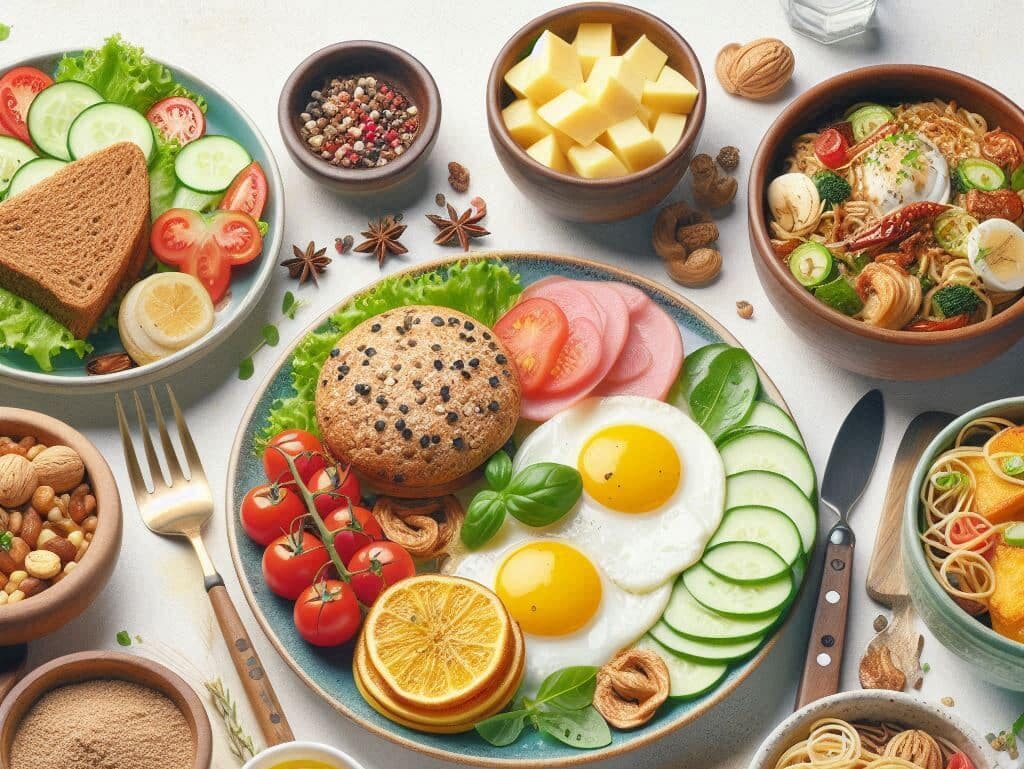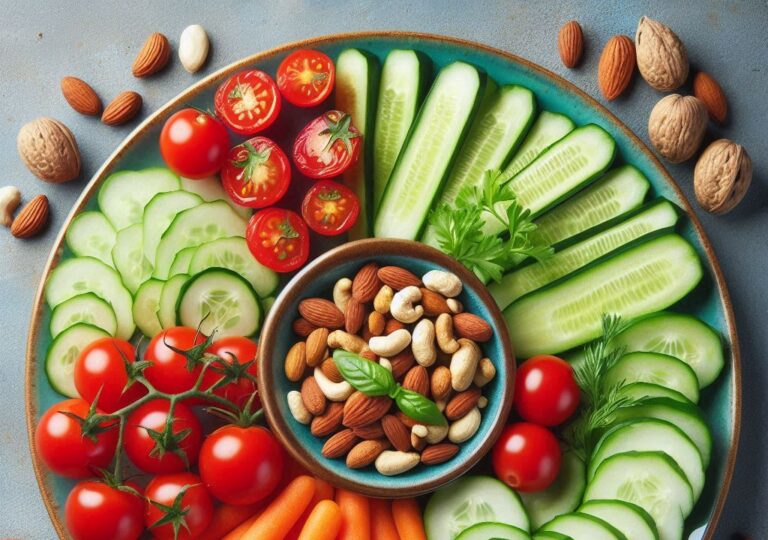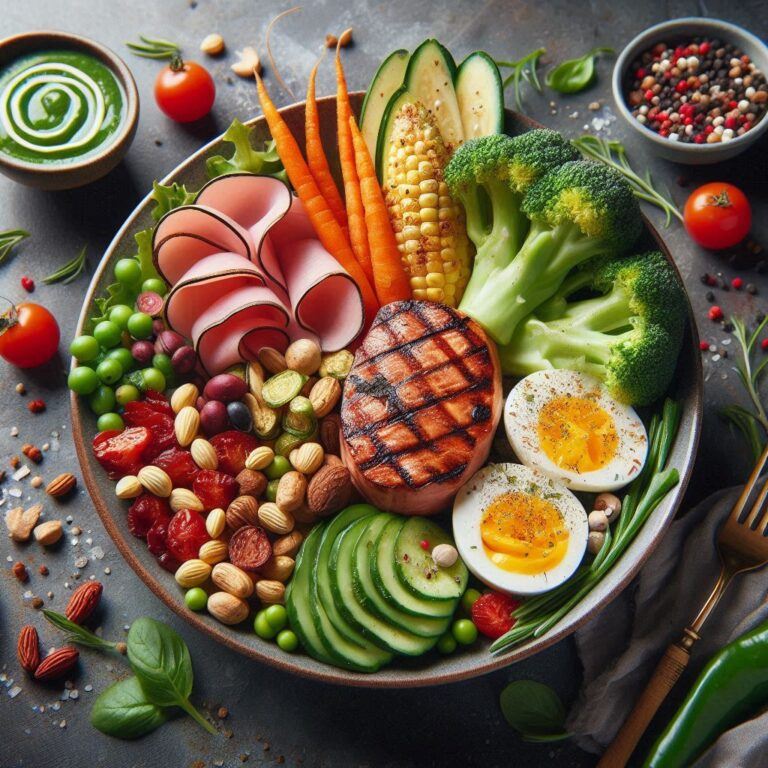Easy and Delicious Recipes for Intermittent Fasters: Top 15 Meals to Try
Are you looking for easy and delicious recipes for intermittent fasters?
You’ve come to the right place! This article covers a variety of recipes that are quick to prepare and full of flavor, ensuring you get the most out of your eating windows while fasting. From breakfast to dinner and snacks, we’ve covered you with meals that support and enhance your intermittent fasting journey.
Key Takeaways
Intermittent fasters can benefit from nutritious and quick meals like avocado toast with poached eggs, green apple smoothies, and scrambled eggs with green onions for breakfast.
For lunch and dinner, try meals packed with lean proteins, healthy fats, and vegetables, such as spicy chicken and avocado wraps, feta and kale sweet potato, oven-baked pork chops and Brussels sprouts, and turkey spaghetti bolognese.
Stay hydrated with water, herbal teas, and black coffee during intermittent fasting, and avoid sugary beverages and alcohol to maintain the benefits of fasting.
Quick and Nutritious Breakfast Ideas
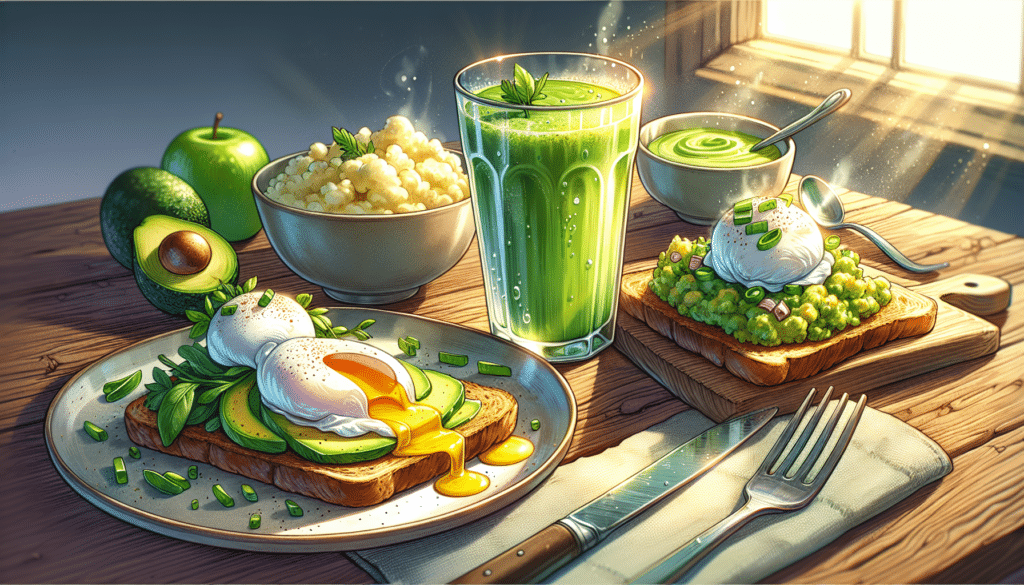
For those who practice intermittent fasting, breakfast takes on a special significance. It can stabilize blood sugar levels and assist in nutrient absorption during fasting periods. A breakfast rich in lean proteins, healthy fats, and whole foods can satisfy you for the day ahead.
Here are three quick and easy breakfast ideas to get you started.
Avocado Toast with Poached Eggs
Avocado toast with poached eggs is a staple in many healthy meal plans, and for good reason. Mash ripe avocado onto a slice of wheat toast and a perfectly poached egg to make this delicious dish. This mixture of healthy fats from the avocado and the protein will keep you satiated and energized throughout the morning.
Additionally, this meal requires less than 10 minutes to prepare, making it a speedy option.
Green Apple Smoothie
For a refreshing and antioxidant-rich drink, try a green apple smoothie. Here’s how to make it:
Blend a green apple
Add a handful of spinach
Add a cucumber
Add a dash of lemon juice
Blend until smooth
This smoothie is packed with antioxidants from the apple and spinach, and the lemon juice boosts vitamin C. Enjoy the added zing of fresh ginger in this nutritious blend!
This nutrient and energy-rich smoothie is an excellent kick-start for your day.
Scrambled Eggs with Green Onions
Scrambled eggs with green onions are a protein-rich and easy-to-make breakfast option. Whisk together eggs and cook them with chopped green onions over medium heat until they reach your desired consistency.
With their high protein bioavailability, eggs are optimal for breaking your fast and energizing your morning activities.
Satisfying Lunch Recipes
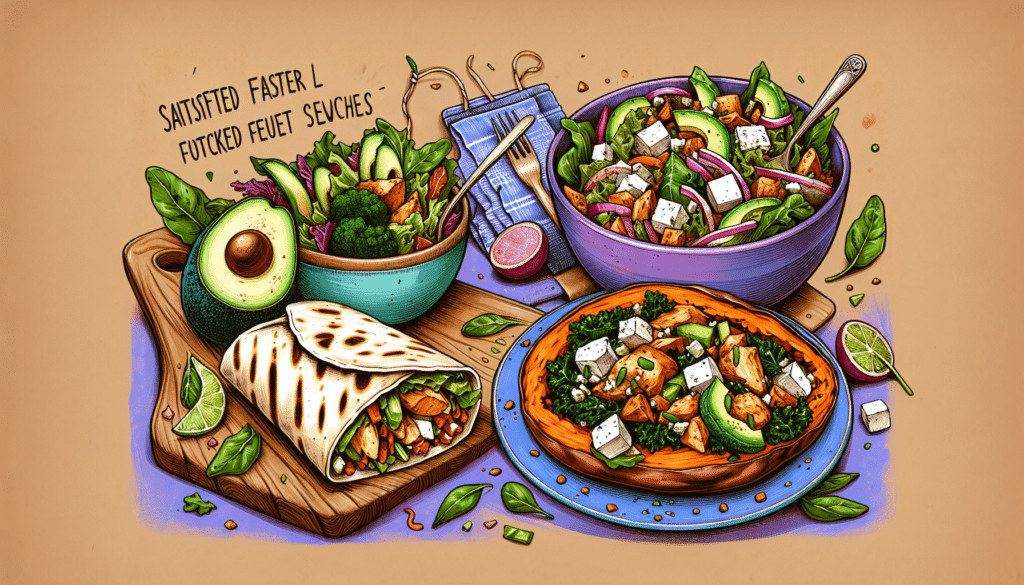
Lunch is an opportune time to nourish your body with energy-boosting, nutritious foods for maintaining daily habits. A satisfying midday meal can keep you energized and prevent afternoon sluggishness. Here are three tasty lunch recipes that blend healthy fats, lean proteins, and vegetables.
Spicy Chicken & Avocado Wraps
Spicy chicken & avocado wraps are packed with flavors and nutrients. Here’s how to make them:
Start by coating chicken breast in chili powder and lemon juice.
Cook the chicken with garlic and red bell pepper.
Assemble the wraps with mashed avocado and wholegrain wraps for lean protein and healthy fats.
These wraps offer more than just a rich flavor; they provide a balanced meal that ensures fullness and satisfaction.
Feta & Kale Sweet Potato
For a flavorful and nutrient-dense meal, try feta & kale sweet potato. Here’s how to make it:
Bake sweet potatoes until tender.
Top the sweet potatoes with wilted kale.
Add roasted chickpeas.
Sprinkle marinated red onion on top.
Crumble feta cheese over the dish.
Finish with a sprinkle of pumpkin seeds.
Enjoy!
The blend of salty and sweet flavors and the nutritional benefits of sweet potatoes and kale make this dish a perfect lunch option.
Veggie-Packed Cheesy Chicken Salad
The vegetable-filled cheesy grilled chicken salad is a nutritious option, perfect for a sandwich or as a standalone dish. Combine lean chicken with various vegetables and a small amount of cheese for a balanced and satisfying meal.
The salad turns out great when using pre-cooked chicken, making it a convenient and speedy lunch choice, especially when paired with a canned soup.
Hearty Dinner Options
Concluding your eating window with a filling dinner can help sustain energy levels and support your fasting period. An ideal dinner should encompass proteins, healthy fats, and various vegetables.
Here are three dinner recipes that are both delicious and nutritious, making them perfect for your meal plan.
Oven-Baked Pork Chops & Brussels Sprouts
Oven-baked pork chops & Brussels sprouts are a flavorful and satisfying dinner option. Rub pork chops with a brown sugar and rosemary mixture, then bake at 425°F for 22-26 minutes.
After baking, broil the apple and Brussels sprouts mixture for a few minutes until browned and slightly charred. This dish provides a perfect balance of sweet and savory flavors.
Turkey Spaghetti Bolognese
Turkey spaghetti bolognese is a healthy twist on a classic dish. Here’s how to make it:
Heat the olive oil in a large-sized pan on medium heat until it shimmers.
Then add minced garlic and diced onions, cooking them until they turn translucent.
Add ground turkey and cook it until it’s not pink.
Pour in crushed tomatoes, tomato paste, tomato sauce, and spices like oregano, basil, and pepper.
Let the mixture simmer for 20 minutes to blend the flavors, including garlic powder and soy sauce, creating a nutritious and delicious stir-fry meal.
Shrimp Scampi with Pasta
Shrimp scampi with pasta is a quick and easy seafood dish perfect for a protein-rich dinner. Sauté shrimp for 2-3 minutes until they are pink and opaque, then combine with cooked pasta and a flavorful sauce.
Besides being delicious, this dish with sour cream is a beneficial source of protein and healthy fats.
Delicious Snack Recipes
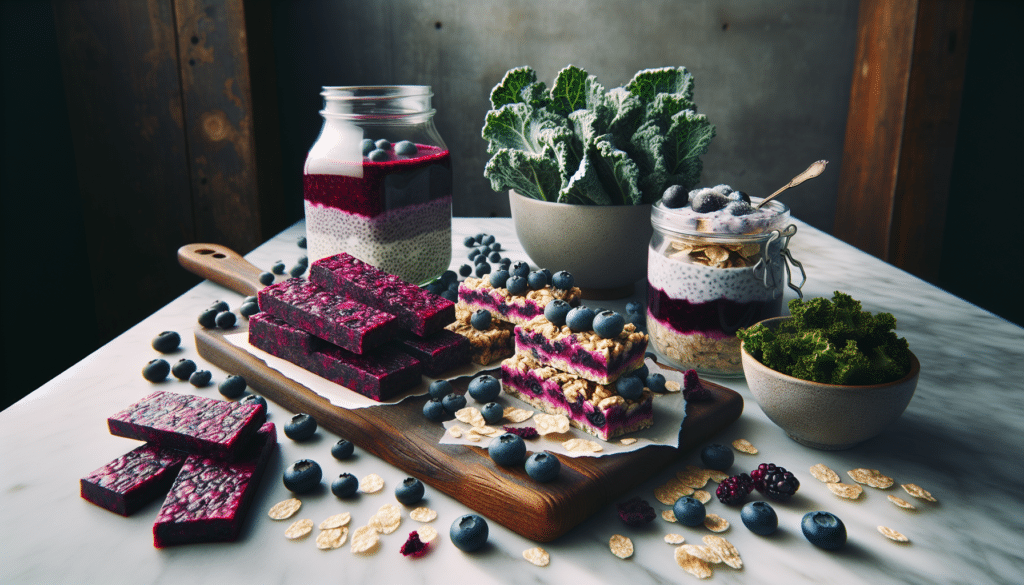
Wholesome snacks are pivotal in maintaining energy levels and promoting overall health during your eating window. They can encompass a variety of fruits, nuts, seeds, and dairy products.
Here are three snack recipes that are both delicious and nutritious.
Blueberry Oatmeal Protein Bars
Blueberry oatmeal protein bars are a healthy and portable snack option. Set the oven to 350°F and place grease in an 8-inch square pan. Combine whole oats, oat flour, brown sugar, salt, and baking soda, then stir in eggs, almond milk, butter, and vanilla.
Fold in blueberries and walnuts, spread the mixture into the pan, and top with shredded coconut. Bake until golden brown, about 35 minutes, and let cool before cutting into squares.
Berry Chia Pudding
Berry chia pudding is a nutrient-rich snack made with chia seeds. Soak the seeds in almond milk and let them form a jelly-like consistency. Mix in fresh berries for added flavor and nutrients.
Chia seeds are rich in fiber, omega-3 fatty acids, and plant-based protein, making this pudding a satisfying and healthy snack.
Crispy Kale Chips
Crispy kale chips are a healthy choice for traditional chips. Here’s how to make them:
Preheat the oven to 275°F.
Prepare fresh kale leaves by removing the stems and tearing them into bite-sized pieces.
Pitch the kale with olive oil and sprinkle with sea salt.
Arrange the kale on a baking sheet.
Bake for 20-25 minutes until the edges are brown but not burnt.
Enjoy your homemade kale chips!
Allow the chips to cool before enjoying them, and store them in an airtight container to keep them crispy.
Top Hydration Tips During Intermittent Fasting
Hydration is imperative during intermittent fasting, as the risk of dehydration can increase with prolonged fasting. Consuming water aids in managing hunger and sustaining energy levels throughout the fasting window.
Here are some top hydration tips, including recommended drinks and drinks to avoid.
Recommended Drinks
Drink plenty of water, herbal teas, and black coffee to stay hydrated during intermittent fasting. Healthy adults should start with 30-35 mL of water per kg of body weight and adjust based on activity and environment. Herbal teas are an excellent option for hydration without breaking your fast, and black coffee can be enjoyed without sugar or cream. Be mindful of urine color as a hydration indicator: clear urine may indicate overhydration, while concentrated yellow urine suggests dehydration.
Drinks to Avoid
During intermittent fasting, avoid sugary beverages and alcoholic drinks. Sugary drinks can break your fast and disrupt the benefits of fasting, while alcoholic drinks are high in calories and can adversely impact your fasting period.
Awareness of the drinks to avoid is essential in preserving the efficacy of intermittent fasting.
Essential Tips for Creating Your Intermittent Fasting Recipes
Crafting your intermittent fasting recipes offers flexibility and customization. Aim to balance macronutrients such as proteins, fats, and carbohydrates for sustained energy levels and health benefits during fasting. Here are some essential tips, including foods to include and foods to avoid.
Foods to Include
Incorporate nutrient-dense foods into your intermittent fasting recipes during your intermittent fasting journey, such as:
Lean proteins like chicken, pork, turkey, seafood, and eggs
Healthy fats from avocados and olive oil
Whole grains for sustained energy.
To support gut health, remember to include fiber-rich vegetables like broccoli and cauliflower and probiotic-rich foods like yogurt and kefir.
Foods to Avoid
Avoid high-calorie, low-nutrient foods such as sugary snacks and refined carbs like white bread, which can directly lead to blood sugar spikes and energy crashes. Fruits should also be avoided as the first meal after fasting to prevent blood sugar spikes. Additionally, steer clear of fried foods to reduce unhealthy fat intake.
Prioritizing whole foods over processed alternatives can amplify the health benefits of intermittent fasting.
Summary
Intermittent fasting (IF) can be an effective and sustainable approach to improving your health when paired with nutritious and balanced meals. From quick and nutritious breakfast ideas to satisfying lunches, hearty dinners, and delicious snacks, our recipes provide various options to energize and satisfy during your eating windows. Staying hydrated with recommended drinks and avoiding sugary and alcoholic beverages is also crucial for maintaining the benefits of fasting.
Remember, creating your intermittent fasting recipes allows for flexibility and personalization. Focus on incorporating lean proteins, healthy fats, and whole foods while avoiding high-calorie, low-nutrient options. With these recipes, you can enjoy a fulfilling intermittent fasting journey that supports your overall health and well-being. Start experimenting in the kitchen and uncover the joy of nurturing your body with delicious and wholesome foods.
If you liked this article, you should read my other post, 10 Delicious Healthy Dinner Ideas Under 500 Calories.
Engage with Me!
Ask Questions: If you have any questions about this article, then leave them in the comment below.
Frequently Asked Questions
What are some good breakfast options for intermittent fasting?
Some good breakfast options for intermittent fasting include avocado toast with poached eggs, green apple smoothies, and scrambled eggs with green onions. Try these for a delicious and nutritious start to your day!
How can I stay hydrated during intermittent fasting?
To stay hydrated during intermittent fasting, focus on drinking plenty of water, herbal teas, and black coffee. Avoid sugary beverages and alcohol to maintain hydration and maximize the fasting benefits.
What should I avoid eating after breaking a fast?
After breaking a fast, avoid high-calorie, low-nutrient foods, refined carbs, and fruits to prevent blood sugar spikes and energy crashes. This will help stabilize energy levels and prevent discomfort.
Can I create my intermittent fasting recipes?
Absolutely! When creating your intermittent fasting recipes, focus on balancing proteins, fats, and carbohydrates, and opt for nutrient-dense over processed foods. This will help support your fasting goals and overall well-being.
What are some healthy snack options for intermittent fasting?
Some healthy snack options for intermittent fasting are blueberry oatmeal protein bars, berry chia pudding, and crispy kale chips. Enjoy!

